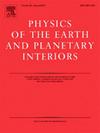Shared periodicities between the length of day and the geomagnetic field at millennial timescales
IF 1.9
3区 地球科学
Q2 GEOCHEMISTRY & GEOPHYSICS
引用次数: 0
Abstract
The dynamics of Earth's outer core control the geomagnetic field and produce variations in the length of day (LOD). This phenomenon has been extensively studied at decadal and interannual scales but is still little known on the millennial timescale. Reconstructed variations in the length of day from ancient records of eclipses exhibit an oscillating component with a millennial period that cannot be explained by tidal effects, glacial isostatic adjustment or the ocean and atmospheric dynamics. In this work, frequency analysis and correlation techniques have been applied to LOD variations and to the dipole and quadrupole geomagnetic field provided by paleomagnetic reconstructions. We found that the non-tidal fluctuations of the LOD are correlated with the paleosecular variation of the Earth's magnetic field over the last three millennia. In particular, LOD maxima occur when the eccentric dipole shifts towards the Pacific region and the geocentric dipole becomes more axial, and LOD minima correspond to a more centred eccentric dipole and a more tilted geocentric dipole towards Atlantic region. These results provide new information about the coupling between the Earth's rotation and the paleosecular variation of the geomagnetic field on millennial time scales.

日长和地磁场在千年时间尺度上的共同周期性
地球外核的动力学控制着地磁场并产生日长(LOD)的变化。这一现象已在年代际和年际尺度上得到了广泛的研究,但在千年尺度上仍知之甚少。从古代日食记录中重建的日长变化表现出一种以千年为周期的振荡成分,这种振荡成分不能用潮汐效应、冰川均衡调整或海洋和大气动力学来解释。在这项工作中,频率分析和相关技术应用于LOD变化和古地磁重建提供的偶极子和四极子地磁场。我们发现LOD的非潮汐波动与近三千年来地球磁场的古长期变化相关。其中,LOD最大值出现在偏心偶极子向太平洋地区移动、地心偶极子向轴向倾斜时,LOD最小值对应于偏心偶极子向大西洋地区偏心和地心偶极子向大西洋地区倾斜。这些结果为地球自转与古地球磁场在千年时间尺度上的耦合提供了新的信息。
本文章由计算机程序翻译,如有差异,请以英文原文为准。
求助全文
约1分钟内获得全文
求助全文
来源期刊

Physics of the Earth and Planetary Interiors
地学天文-地球化学与地球物理
CiteScore
5.00
自引率
4.30%
发文量
78
审稿时长
18.5 weeks
期刊介绍:
Launched in 1968 to fill the need for an international journal in the field of planetary physics, geodesy and geophysics, Physics of the Earth and Planetary Interiors has now grown to become important reading matter for all geophysicists. It is the only journal to be entirely devoted to the physical and chemical processes of planetary interiors.
Original research papers, review articles, short communications and book reviews are all published on a regular basis; and from time to time special issues of the journal are devoted to the publication of the proceedings of symposia and congresses which the editors feel will be of particular interest to the reader.
 求助内容:
求助内容: 应助结果提醒方式:
应助结果提醒方式:


